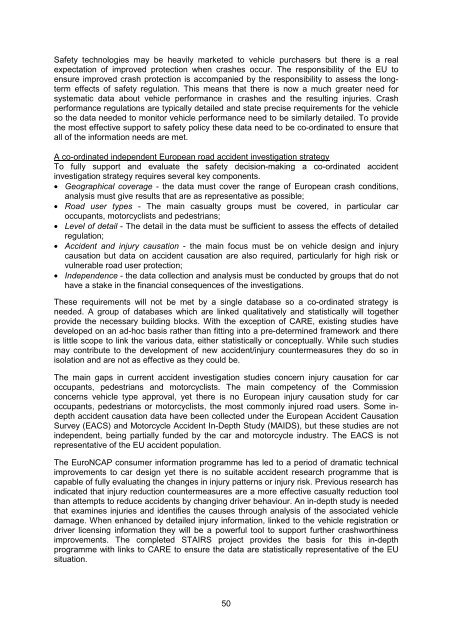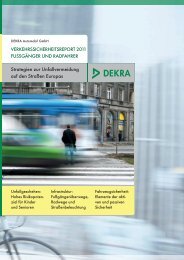PRIORITIES FOR EU MOTOR VEHICLE SAFETY DESIGN
priorities for eu motor vehicle safety design - ETSC
priorities for eu motor vehicle safety design - ETSC
Create successful ePaper yourself
Turn your PDF publications into a flip-book with our unique Google optimized e-Paper software.
Safety technologies may be heavily marketed to vehicle purchasers but there is a real<br />
expectation of improved protection when crashes occur. The responsibility of the <strong>EU</strong> to<br />
ensure improved crash protection is accompanied by the responsibility to assess the longterm<br />
effects of safety regulation. This means that there is now a much greater need for<br />
systematic data about vehicle performance in crashes and the resulting injuries. Crash<br />
performance regulations are typically detailed and state precise requirements for the vehicle<br />
so the data needed to monitor vehicle performance need to be similarly detailed. To provide<br />
the most effective support to safety policy these data need to be co-ordinated to ensure that<br />
all of the information needs are met.<br />
A co-ordinated independent European road accident investigation strategy<br />
To fully support and evaluate the safety decision-making a co-ordinated accident<br />
investigation strategy requires several key components.<br />
• Geographical coverage - the data must cover the range of European crash conditions,<br />
analysis must give results that are as representative as possible;<br />
• Road user types - The main casualty groups must be covered, in particular car<br />
occupants, motorcyclists and pedestrians;<br />
• Level of detail - The detail in the data must be sufficient to assess the effects of detailed<br />
regulation;<br />
• Accident and injury causation - the main focus must be on vehicle design and injury<br />
causation but data on accident causation are also required, particularly for high risk or<br />
vulnerable road user protection;<br />
• Independence - the data collection and analysis must be conducted by groups that do not<br />
have a stake in the financial consequences of the investigations.<br />
These requirements will not be met by a single database so a co-ordinated strategy is<br />
needed. A group of databases which are linked qualitatively and statistically will together<br />
provide the necessary building blocks. With the exception of CARE, existing studies have<br />
developed on an ad-hoc basis rather than fitting into a pre-determined framework and there<br />
is little scope to link the various data, either statistically or conceptually. While such studies<br />
may contribute to the development of new accident/injury countermeasures they do so in<br />
isolation and are not as effective as they could be.<br />
The main gaps in current accident investigation studies concern injury causation for car<br />
occupants, pedestrians and motorcyclists. The main competency of the Commission<br />
concerns vehicle type approval, yet there is no European injury causation study for car<br />
occupants, pedestrians or motorcyclists, the most commonly injured road users. Some indepth<br />
accident causation data have been collected under the European Accident Causation<br />
Survey (EACS) and Motorcycle Accident In-Depth Study (MAIDS), but these studies are not<br />
independent, being partially funded by the car and motorcycle industry. The EACS is not<br />
representative of the <strong>EU</strong> accident population.<br />
The EuroNCAP consumer information programme has led to a period of dramatic technical<br />
improvements to car design yet there is no suitable accident research programme that is<br />
capable of fully evaluating the changes in injury patterns or injury risk. Previous research has<br />
indicated that injury reduction countermeasures are a more effective casualty reduction tool<br />
than attempts to reduce accidents by changing driver behaviour. An in-depth study is needed<br />
that examines injuries and identifies the causes through analysis of the associated vehicle<br />
damage. When enhanced by detailed injury information, linked to the vehicle registration or<br />
driver licensing information they will be a powerful tool to support further crashworthiness<br />
improvements. The completed STAIRS project provides the basis for this in-depth<br />
programme with links to CARE to ensure the data are statistically representative of the <strong>EU</strong><br />
situation.<br />
50



